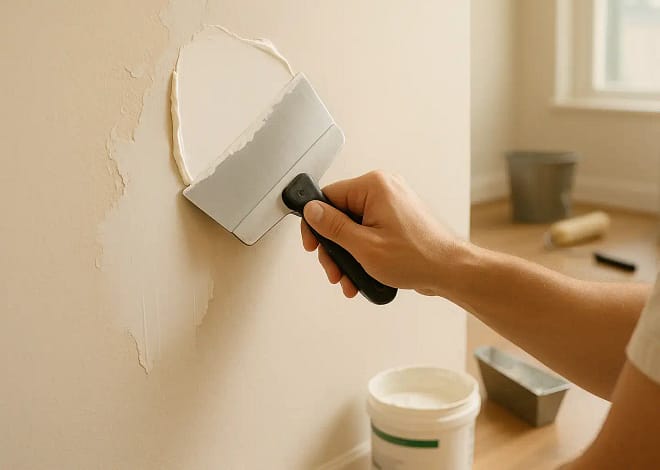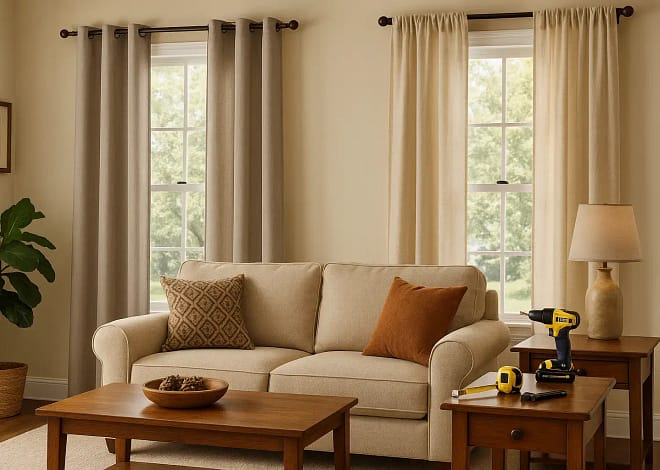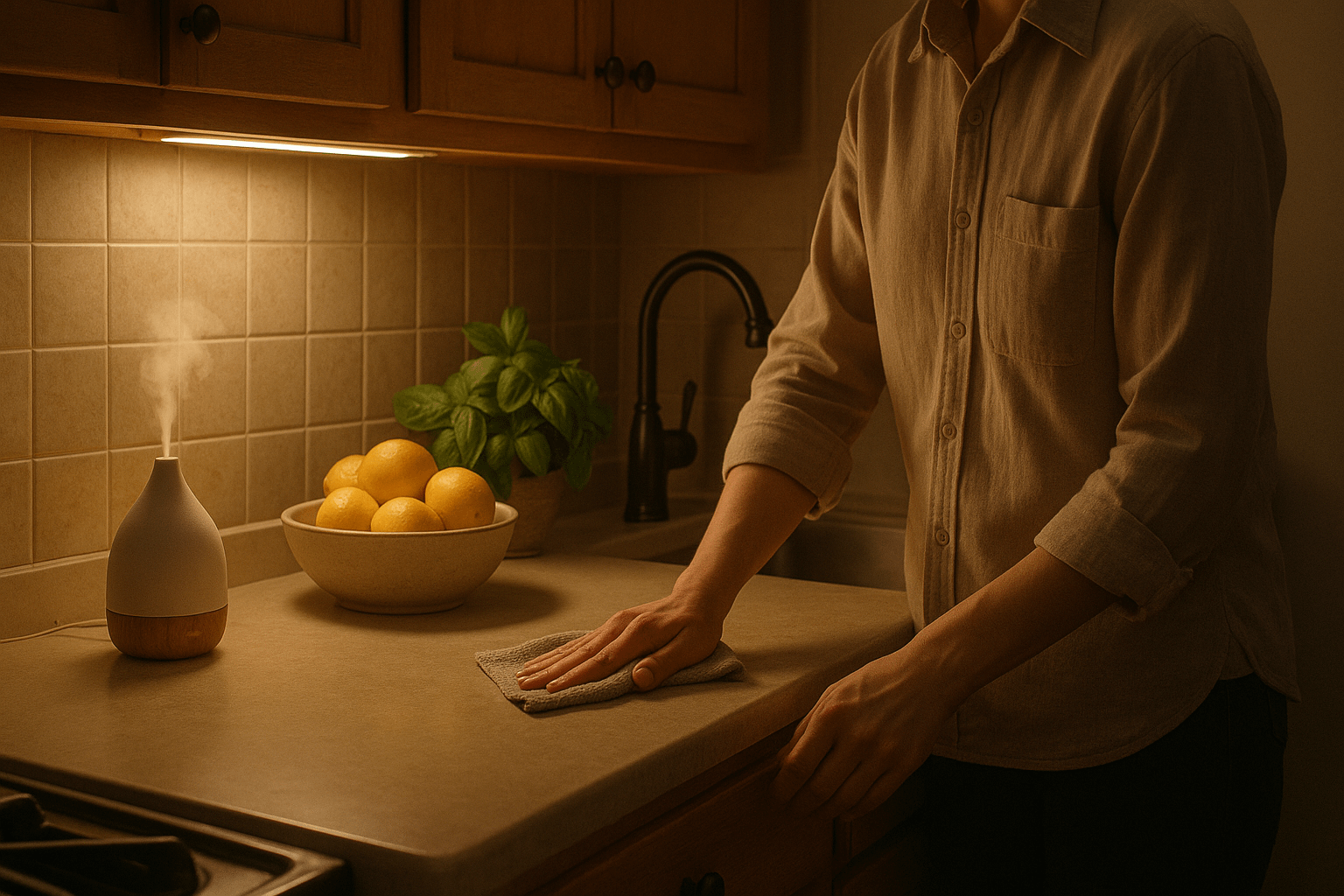
Best 7 Natural DIY Indoor Fly Killers That Are Safe for Your Family and Pets
Intro: Why You Should Say No to Chemical Fly Killers Indoors
I’ll be honest. A few summers back, I thought I had my indoor fly problem all figured out. The weather had just started warming up, and like clockwork, the flies arrived. So, I grabbed a can of store-bought fly spray, did a quick round in the kitchen, and moved on with my day. But within minutes, the entire house reeked of chemicals. My dog, Max, started sneezing. My toddler wandered dangerously close to a freshly sprayed surface. And I stood there realizing something. I had just traded flies for fumes.
That moment was a turning point.
It’s crazy how we’ve been conditioned to reach for chemical-laden products without thinking twice. But when you live with pets, kids, or simply value the air you breathe, it’s worth asking the question: is this really the best solution? That single question led me down a path of researching, testing, and at times failing with countless natural fly killer methods for indoor use.
And here’s what I discovered. Natural solutions do work. Some are better than others, and I’ll walk you through which ones worked for me. But more importantly, they allow you to reclaim your space in a way that feels safe for your family. No toxins in the air. No artificial fog hanging in the kitchen. No worrying if your puppy is licking pesticide residue off the floor tiles.
In this post, I’m going to share seven tried-and-tested natural indoor fly killers that actually made a difference in my home. Some are simple DIY tricks. Others are inexpensive products you can buy right away. And a couple were surprising little fixes that overperformed in ways I didn’t expect.
If you’re tired of battling flies with the chemical warfare approach and want something that supports a healthier, more mindful home life, you’re in the right place.
Let’s clear the air, both literally and intentionally.
What Attracts Flies Indoors and Why That Matters
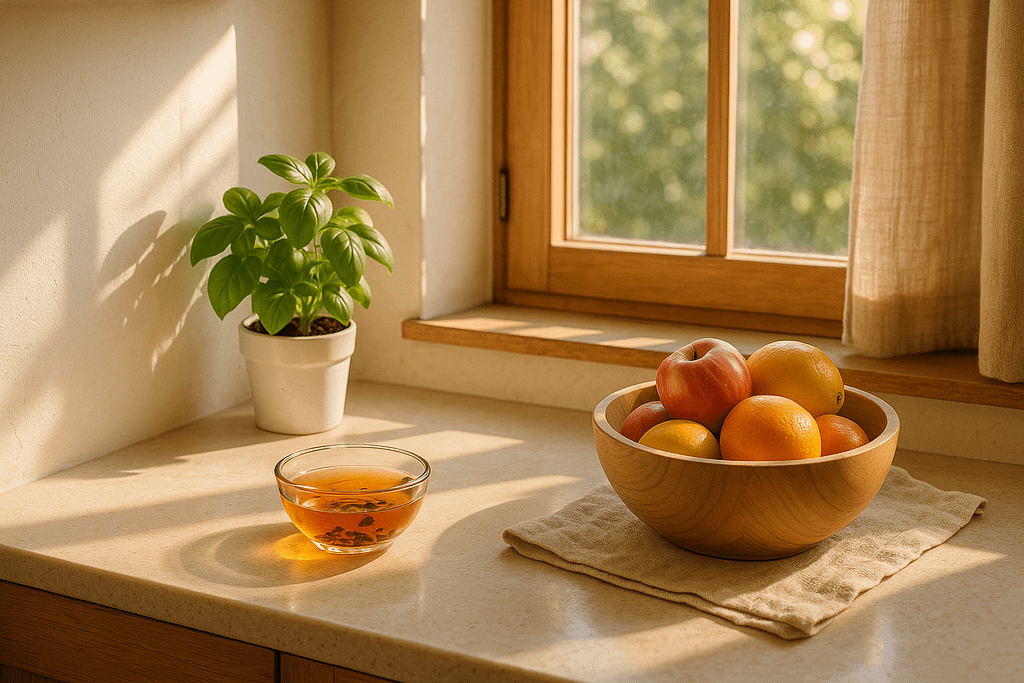
Before we dive into natural fly killers, let’s talk about the real root of the problem. If you’ve ever wondered why flies just seem to know when you’re preparing dinner, or why they suddenly appear when the fruit bowl ripens a little too fast, you’re not imagining things.
Flies are incredibly sensitive to scents, especially sugary or fermented ones. What we barely notice, they can detect from across the house. That half-empty soda can, the banana that’s just turned spotty, or the scraps in your compost bin? That’s basically a dinner bell for common houseflies.
I learned this the hard way. Last year, I had a tiny fly explosion in my kitchen after hosting a weekend barbecue. I hadn’t even left much out, just a few fruit peels and a juice box on the counter. By the next day, I noticed flies clustering along the windowpanes. It wasn’t until I deep cleaned the disposal and wiped down a few sticky spots on the counter that they started to disappear.
That’s when it clicked. You can’t just deal with flies; you have to understand what’s attracting them in the first place.
Here are some of the most common indoor fly magnets:
- Overripe fruit and sugary foods
- Open trash or compost bins
- Pet food bowls left out too long
- Dirty dishes and sponges
- Damp mops or cleaning cloths
- Clogged sinks and drains
- Houseplants with overly wet soil
If you’re dealing with flies regularly, chances are one or more of these is consistently triggering the problem.
Now, knowing this doesn’t just help us prevent infestations. It also helps us choose smarter fly-killing strategies. For example, if flies are swarming near your garbage bin, placing a vinegar trap in the opposite corner of the room won’t do much. But placing it right next to the source will multiply your results.
Understanding fly behavior also explains why some natural remedies get a bad rap. It’s not that vinegar traps don’t work. It’s that we often use them in the wrong context or without removing the root cause first.
So when we talk about natural fly killers, we’re not just looking for things that eliminate flies on contact. We’re looking for solutions that work in harmony with a clean and well-managed space. In my experience, it’s that combination – cleanup plus natural methods – that creates long-term results.
In the next section, I’ll take you through the top natural solutions I’ve personally tested, starting with ones that take just minutes to set up.
Ready to take back control of your kitchen, bathroom, or living space? Let’s get into it.
The Top 7 Natural Indoor Fly Killers (Tested and Safe for the Whole Family)
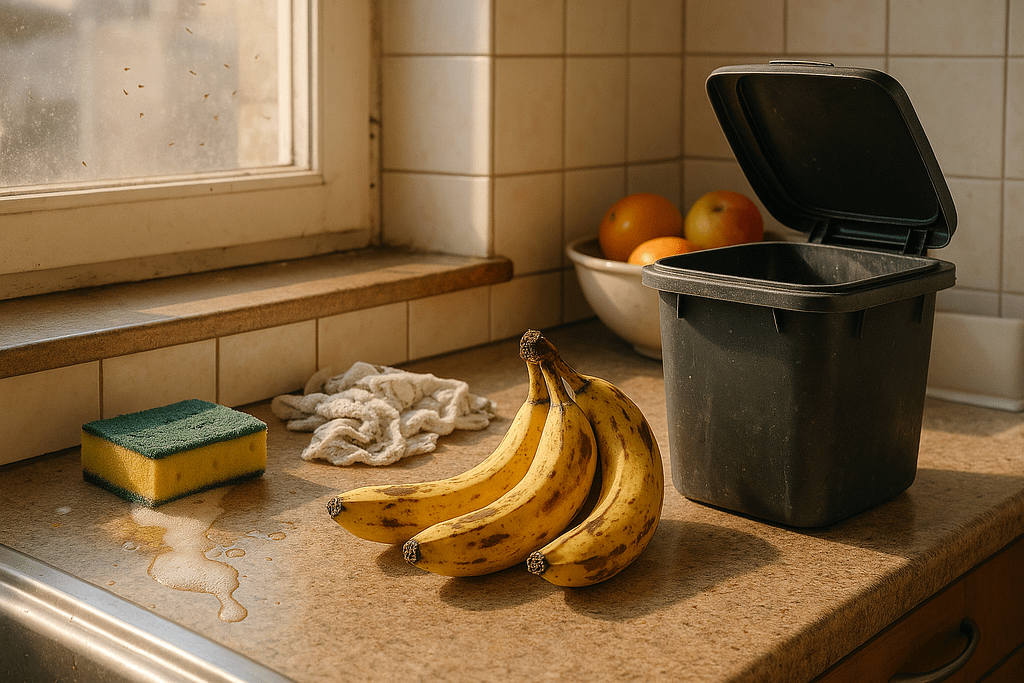
Over the past couple of years, I’ve tried pretty much every natural fly-killing method out there. Some worked instantly. Some were just hype. And a few surprised me with how simple and effective they really were. What follows isn’t just a generic list. It’s my personal shortlist of go-to remedies that have actually reduced or eliminated fly problems in my own home.
Each method below is safe to use indoors, won’t contaminate your air or surfaces, and is either pet-friendly or has a safe-use workaround.
Let’s start with one of the easiest and most oddly satisfying solutions.
1. Vinegar and Dish Soap Trap
What It Is: A DIY trap made from apple cider vinegar, dish soap, and a small bowl or jar.
Why It Works: Flies have a strong nose for anything sweet and sour, especially the scent of fruit that’s starting to go soft. Apple cider vinegar mimics that scent, luring them in. Thanks to the soap, the surface loses its grip, and the flies quickly go under with no way to escape.
How I Use It: I pour a bit of apple cider vinegar into a shallow bowl and add a drop or two of natural dish soap. No need to stir. I like to keep it near areas where flies tend to hang around, like the trash corner or fruit bowl. Within an hour, I usually see results.
Personal Experience: I still recall testing this out for the first time and thinking it might be another dud. I wasn’t expecting much, honestly. But by the next morning, four little fruit flies were floating in the bowl. It felt like a weird tiny victory. I now keep one of these traps near my sink almost every summer evening.
Safety Note: Completely safe around pets and kids if placed out of reach. Still, don’t use it in an area where your dog might drink it just out of curiosity.
2. Basil and Mint Plants
What It Is: Live herbs like basil, mint, or even lavender placed in pots around the home.
Why It Works: These aromatic plants emit natural oils that repel flies. They act like living air fresheners with a purpose.
How I Use It: I keep a basil plant near the kitchen window and a pot of peppermint on the bathroom counter. You’d be surprised how well it works in small spaces.
Personal Experience: One summer I moved my indoor plants out to the balcony and immediately noticed flies creeping back into the kitchen. I put a basil plant back on the sill, and within a day, they were gone. It may not be bulletproof, but it makes a noticeable difference.
Safety Note: Most herbs are safe for homes with pets, but peppermint can be irritating for cats, so place it wisely.
3. Essential Oil Diffusers (Lavender, Peppermint, Eucalyptus)
What It Is: A diffuser disperses tiny particles of essential oils into the air to create a natural fly-repelling mist.
Why It Works: Oils like peppermint, lavender, and eucalyptus are known for repelling various insects, including flies, mosquitoes, and even ants.
How I Use It: I use a basic water-based diffuser with a few drops of lavender oil in the hallway and peppermint in low-traffic zones. Bonus, your house smells like a spa.
Personal Experience: I had high hopes for diffusers, and while they’re not as fast-acting as vinegar traps, I love using them at night. They work well to prevent flies instead of just catching them. My favorite combo is clove and peppermint, and it gives the house an amazingly clean scent.
Safety Note: Be extra cautious if you have pets, especially cats. Some essential oils that work on flies can cause issues for pets, especially cats. Always ventilate and diffuse in well-aired spaces.
4. Clove-Pierced Citrus (Lemon + Clove Combo)
What It Is: A folk remedy where you pierce a halved lemon with whole cloves.
Why It Works: The combination of citrus oils and clove creates a scent that deters flies while also feeling fresh and non-toxic.
How I Use It: I slice a lemon in half and stick 10 to 15 cloves into the flesh. It makes a nice centerpiece for your kitchen or coffee table and works as both décor and deterrent.
Personal Experience: This was one of the more surprising ones. I tried it for fun during the holidays and noticed mosquitoes and flies stopped hovering around the fruit bowl. It won’t wipe out a swarm, but it’s perfect for prevention when guests are over.
Safety Note: Completely pet-friendly and kid-safe, though clove can be strong. Avoid letting little ones handle it directly.
5. Yellow Sticky Traps (Natural, Unscented Types)
What It Is: Bright yellow adhesive traps that attract and capture flies without chemicals.
Why It Works: The yellow color mimics flowers or fruit, luring flies in. It may sound low-tech, but it taps into basic insect behavior.
How I Use It: I stick them in places flies like to hover, such as window corners, above the kitchen sink, or behind the trash bin. Choose flat, discreet versions that blend in with your home.
Personal Experience: These work like magic, especially near warm windows. I was reluctant at first because flypaper looked awful, but there are modern designs now that are minimalist and don’t scream pest problem.
Safety Note: Safe for pets but should be kept up high to avoid accidental paw contact.
6. UV Light Fly Zappers (Non-Toxic Indoor-Friendly Models)
What It Is: Electronic devices that use UV light to attract and trap flies in a container grid.
Why It Works: Certain wavelengths of UV light naturally attract flies. These devices simulate outdoor lighting conditions that bugs are drawn to.
How I Use It: I place one near the entry to the living room in the evenings. They work best when used in dark or dim areas, usually overnight.
Personal Experience: I had mixed feelings about these. On one hand, they’re effective with persistent flies. On the other, they’re not something I’d leave in the center of a nicely styled room. Super effective as a background defense, though.
Safety Note: No toxins at all, but keep cords out of reach from pets or small children.
7. Your Cleaning Habits Are the Unsung Hero
What It Is: Targeted cleaning of garbage areas, spill-prone spots, and drains.
Why It Works: Eliminating the source of attraction is more powerful than any trap.
How I Use It: I spray down counters with a vinegar solution every evening, take out the trash at night instead of in the morning, and clean my kitchen sink with baking soda and lemon peel once a week.
Personal Experience: None of the natural methods worked optimally until I paired them with a solid cleaning routine. Seriously, this step amplified everything else. If you skip this, expect flies to keep coming back no matter what else you try.
Safety Note: Natural cleaners like vinegar or baking soda are safe and effective. Just skip harsh bleaches and artificial fragrances when possible.
Each of these methods brings something unique to the table. Depending on your setup and lifestyle, some might work better for you than others. The beauty of natural fly control is that you can layer these solutions to create a fly-free environment without ever reaching for that chemical spray can again.
Coming up next, I’ll clear up some common myths I’ve come across, including why that lemon water trick might not be doing what you think it is.
Common Natural Fly Repellent Myths Busted
When I first started experimenting with natural fly repellents, I fell into a few traps. Not the literal ones I set around my kitchen, but the ones made up by bad advice and half-truths online. Google “natural ways to get rid of flies” and you’ll come across hundreds of DIY tricks, some of which sound amazing but barely work in real life.
Let’s break down some common myths and get to the real story. Here are some of the most common fly-fighting myths I’ve come across, and what really happened when I tried them.
Myth 1: Just open a window and they’ll fly out
Reality: If only it were that simple. Once flies enter a cozy, temperature-controlled room with a buffet of smells, they’re not eager to leave. I’ve had flies buzz right past wide-open windows or hover around the window panes, confused but still not going outside.
What Actually Helps: Instead of opening a window and hoping for the best, try placing a natural fly trap near the exit. Light positioning also plays a big role. Flies tend to navigate toward light, so giving them both an exit and a reason to leave, like eliminating food sources, works better.
Myth 2: Leave out a bowl with a few lemon slices floating in water. That’ll keep flies away
Reality: I tested this one with high expectations, partly because it looked nice. Unfortunately, flies were completely unfazed. In fact, they seemed more drawn to my actual lemons than repelled by them floating in water.
Why It Falls Flat: Lemon water doesn’t have the strong citrus oil concentration that repellents require. And unless you’re using lemon essential oil in large quantities, the scent dissipates too quickly to matter.
What Actually Helps: If you like the citrus angle, go all in with clove-studded lemons or citrus oil diffusers. These emit stronger, longer-lasting aromas that are known to repel flies more effectively.
Myth 3: Essential oils are always 100% safe around pets
Reality: This one startled me. I was diffusing peppermint oil in the living room when I noticed our cat acting restless and avoiding the area. That’s when I learned that certain essential oils can actually be toxic to pets, especially cats.
The Truth: Oils like peppermint, tea tree, eucalyptus, and clove are common natural repellents, but they’re not always safe to use around animals. Unlike humans, cats can’t break down many of the ingredients in essential oils, so even brief exposure might cause issues. Dogs have their sensitivities too.
What I Do Now: I diffuse only pet-safe oils like lavender, and always in rooms with good ventilation where my pets don’t spend a lot of time. You can also try dried herbs or plants instead of oils if you’re worried about exposure.
Myth 4: Natural fly killers aren’t as effective as chemical ones
Reality: I used to believe this myself. But after sticking with natural methods for over a year, I can confidently say that natural doesn’t mean weak. It just requires a bit more intention and consistency.
What Changed My Mind: The first time my vinegar trap caught ten flies in a single day, I realized it was about strategy, not strength. Once I paired the right method with hotspot placement, even the most persistent swarm backed off.
What Actually Helps: Layering multiple natural solutions, combined with solid prevention like clean counters and covered trash, creates a more sustainable fly-free environment than regularly spraying toxic residue into the air.
Myth 5: Sticky traps are outdated and ugly
Reality: This one is half true. The old-school dangling spiral strips are kind of hideous. But the newer versions are sleek, minimal, and surprisingly effective.
My Experience: Once I started using low-profile, plant-based sticky pads near my window frames, I caught a dozen flies without even noticing the traps. No mess, no smell, and no chemicals. They get the job done quietly.
Bottom Line
When it comes to dealing with flies naturally, knowledge is just as important as your tools. Knowing what works is essential, but knowing why it works is what empowers you to control the space, not just react to problems.
Don’t let myths keep you in the cycle of trial and error. The more you understand the science and your home environment, the more powerful these simple strategies become. Trust me, your kitchen will thank you.
Next up, I’ll show you how to match the right fly-killing method to your space, your lifestyle, and your family’s needs. Because one size fits all rarely works, especially when it comes to flying pests.
How to Choose the Right Fly Killer for Your Family and Pets
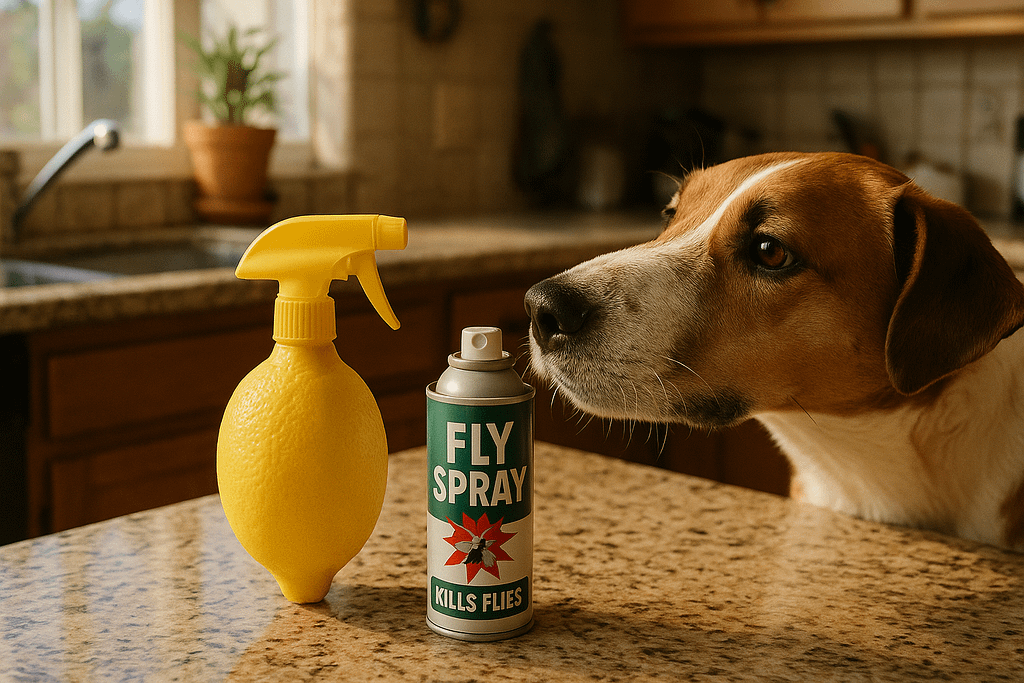
By now, you’ve got a solid list of natural fly killers to work with, but the real magic comes when you select the right method for your home. Not every solution fits every space. What works wonders in a studio apartment might fall flat in a busy family kitchen. What’s perfect for a home with dogs might not be safe for a family with parrots or curious kids.
I’ve tested and adjusted these methods in different areas of my own home because, honestly, what works in theory doesn’t always mesh well with real life. So in this section, I’m walking you through how to choose what’s best for your space, lifestyle, and loved ones.
1. Consider Your Home Layout
Is your home open-plan? Do you have tight hallway corners or lots of natural light? Your floor plan actually changes how and where flies tend to gather. Bright, sunlit kitchens, for example, are common hotspots, especially near windows or sinks.
Natural light tip: If you have large windows, UV light zappers and sticky traps can be extra effective since flies are drawn to these zones naturally. For smaller, enclosed spaces like bathrooms, something like a lemon-clove combo or a basil plant might do the job just fine.
2. Think About Who Lives in Your Home
This part is huge. Natural does not always mean harmless, especially when it comes to tiny hands and four-legged friends who like to explore.
If you have pets:
Go plant-based. From what I’ve tried at home, a few basil or mint plants paired with a vinegar trap can go a long way without any safety concerns.Be cautious with essential oil diffusers, especially if you live with cats. I love how lavender smells, but I only diffuse it in rooms where my pets don’t spend much time.
If you have kids:
Steer clear of breakable or open containers with vinegar traps unless placed well out of reach. I learned that one the hard way after my toddler knocked over a dish soap trap I had on a low shelf. Lesson learned. Now I use covered vinegar jars or opt for sticky pads up high.
3. Match the Method to the Room
Each room has its own fly behavior and risk level. What works in the kitchen may not be necessary in the bedroom.
Here’s how I match fly killers to rooms in my house:
| Room | Recommended Methods |
| Kitchen | Vinegar and dish soap traps, basil or mint plants, sticky traps near garbage bins |
| Living Room | Essential oil diffuser with pet-safe oils, discreet sticky traps by windows |
| Bathroom | Lemon-clove citrus, peppermint plant away from pets, regular drain cleanings |
| Entry Area | UV light zapper near doorway or windows, fly-proof screens, natural air fresheners |
This simple structure helps keep flies under control without overdoing it in every corner of the house. You only need to target the spots where flies actually show up. Just use smart placement where activity is highest.
4. Aesthetic and Lifestyle Fit
Let’s be real. Some of us care about the way our home looks just as much as how it functions. I’m big on keeping things simple and stylish, and I’ll admit, traditional flypaper didn’t fit my vibe.
If you’re like me and want solutions that don’t clash with your décor:
- Choose modern-design sticky traps. There are sleek options now that blend right into your plants or window frames.
- Try herb planters that double as visual accents. A mint plant beside a stack of cookbooks looks intentional and does the job.
- Use diffusers with wood bases or frosted glass that double as design elements, especially in shared spaces.
Function does not have to compromise form. The key is choosing tools that work with your home, not just against the flies.
5. Factor in Maintenance and Time
Some methods work great but require a little commitment. If you’re someone who doesn’t want to fiddle with setups every few days, go for passive solutions like potted repellent herbs or sticky pads. But if you’re like me and don’t mind taking a minute each night to reset a trap or spray a surface, then things like vinegar traps or citrus sprays are totally manageable.
Ask yourself:
- Do I need a low-maintenance option that doesn’t call for daily check-ins?
- Am I okay with mild smells or cleaning up once a week?
- Do I want a solution that works quickly or over time?
Matching your fly control to your schedule is just as important as matching it to the size of your kitchen.
Final Takeaway
Choosing the right natural fly killer isn’t just about buying the trendiest product or trying the first hack you see on social media. It’s about making a plan that works with your home, your routine, and your people (and pets). Once you figure out that balance, everything gets easier.
The goal isn’t perfection. It’s peace of mind. Less buzzing, fewer chemicals, and more confidence that your home is not just fly-free, but clean, safe, and completely lived in.
Coming up in the final section, I’ll share some practical tips to keep your home fresh and fly-free all season long without overcomplicating the process.
Final Tips for a Fly-Free, Fresh-Smelling Home
There’s something deeply satisfying about coming home, opening your front door, and being greeted by a clean space that smells fresh. Not like vinegar traps, not like chemical sprays, but like a home that’s lived in and loved.
Getting rid of flies without using harsh sprays doesn’t mean jumping through hoops. Over time, I’ve realized it’s less about finding one perfect fix and more about building a rhythm. A few small habits, when added together, can keep flies out while also keeping your home smelling good and feeling healthy.
Here are some of the final things I swear by.
1. Tidy Up Before Bed (Even When It’s Tempting Not To)
This one makes a bigger difference than you’d think. Flies are opportunists. They love a crumb-covered counter or a forgotten smoothie glass left overnight. I used to talk myself out of night cleaning all the time, but when I started wiping down the counters and emptying the trash before I went to bed, the difference the next morning was honestly shocking.
My routine in under five minutes:
- Quick vinegar spray wipe-down on counters and stove
- Rinse and cover the kitchen sponge
- Take the trash out or seal the bin
- A quick flush with baking soda followed by hot water helps keep the drain smelling clean and fly-free.
Some nights I drag myself through it, but I never regret it the next morning.
2. Rotate Natural Repellents Seasonally
Just like you wouldn’t wear a heavy coat in July, you don’t need every repellent working full force all year round. In spring and summer, I pull out my basil plants and vinegar traps more often. In the cooler months, a diffuser or a single sticky trap near the window is usually enough.
Giving certain methods a break actually helps keep them more effective over time. Flies adapt, but occasionally switching scents like peppermint one week and lavender the next keeps them guessing.
3. Use Natural Scents to Create an Unwelcoming Environment for Flies
This is my favorite because it doubles as mood-boosting aromatherapy. Scents really do shape how a home feels. The great part is, a lot of the same smells we love like citrus, herbs, and floral oils are completely unappealing to flies.
Some of my favorite fly-fighting scent combos:
- Mint and rosemary in a diffuser
- Lemon and clove placed on the windowsill
- Dried lavender sachets in the bathroom
- Sprigs of fresh basil on the table which also look pretty
Your home ends up smelling clean and calming without relying on synthetic fragrance sprays.
4. Seal the Gaps
This one isn’t exciting, but it’s crucial. No matter how many fly killers you set out, if your windows have gaps or your screen door doesn’t close properly, they’ll keep getting in. I finally fixed the loose seal on my kitchen window last year, and I wish I had done it sooner. The difference was obvious. It didn’t eliminate them completely, but I was seeing maybe 60 percent of what I used to.
Do a quick check around entry points. Even something simple like weather stripping or mesh tape can make all the difference.
5. Make It a Lifestyle, Not Just a One-Time Fix
This is really the heart of it. Natural pest control isn’t about setting a trap and hoping for the best. It’s about building habits that support a cleaner, safer ecosystem at home for your family, your pets, and you.
A fly-free home means having a system that works with your lifestyle, not a glossy-clean Pinterest version of your space. Your kitchen can still be warm, lived-in, and family-filled, just without the buzzing guests.
In Closing
When I first started researching natural fly killers, I thought I’d have to give up convenience and deal with mixed results. I honestly didn’t expect this journey to lead me to a healthier, cleaner, better-smelling home. But it did.
And that’s what I want for you too. Not just a temporary solution, but a cleaner and more conscious home life that feels good to live in.
Once you find a mix that works for your space, things shift quickly – fewer flies, fresher rooms, and a home that just feels better. You don’t need harsh chemicals. The trick is finding a routine that works with your lifestyle, not against it.
Tried something from the list or planning to? Share your pick in the comments below.And if you’ve tested something I haven’t mentioned here, I’d love to hear about it. This space is all about learning and improving together.
Here’s to peaceful, pest-free living, naturally.


